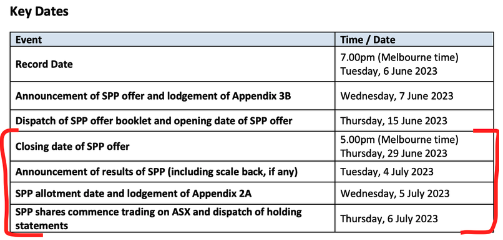What is a Share Purchase Plan?
Published 11-JUL-2023 12:03 P.M.
|
5 minute read
Small cap companies need money to grow, and generally this money is acquired through a capital raise.
A capital raise happens when the company needs money to operate (drill a hole, grow their business, etc...) or has a new project that they want to develop.
As an investor, the hope is that the money spent will be used to drive the company.
There are a number of ways that small caps can use to raise capital including:
- Capital raises with high net worth or institutional investors
- Rights Issues
- Share Purchase Plans
- Convertible notes
- Cash from options exercised
Today we will be talking about Share Purchase Plans and what they mean for you as an investor.
Share Purchase Plans Explained
A Share Purchase Plan (SPP) is a financial offering that allows existing shareholders of a company to purchase additional shares directly from the company at a discounted price.
It is a way for companies to raise additional capital from people who already have a position in the company, without going through the traditional process of issuing new shares to the high net worth individuals or institutional investors.
Here's how a typical Share Purchase Plan works:
- Eligibility: The company specifies the eligibility criteria for participating in the SPP, usually a shareholder will need to own stock at a specific date (also known as the record date).
- Offer details: The company states the number of shares available for purchase, the discounted price, and the timeframe within which shareholders can participate.
- Application: Eligible shareholders can apply for the SPP by submitting an application form along with the required payment for the desired number of shares. The application form is usually provided by the company.
- Allocation: When the SPP closes, the company allocates shares to the applicants.
- Payment: Shareholders who are allocated shares must make the payment within the specified timeframe. The payment is typically made directly to the company.
- Share issuance: Once the payment is received, the company issues the shares and updates the shareholder's ownership records accordingly.
Note that if the total number of applications exceeds the available shares, the company may allocate shares on a pro-rata basis, meaning shareholders receive a proportionate number of shares based on their existing holdings.
Why do companies conduct Share Purchase Plans (SPPs)?
Share Purchase Plans provide existing shareholders with an opportunity to increase their ownership in the company at a discounted price.
Capital raises are often reserved for high net worth individuals or institutional investors.
Retail investors don't often get invited to capital raises, so this is an opportunity for everyday investors who believe in the company's long-term prospects to invest more capital (generally at a discounted price and with free options) without going through the open market.
Participation in an SPP is entirely voluntary, and shareholders can choose whether or not to participate.
SPPs are a cost-effective investment option with lower transaction costs compared to buying shares on the open market (no brokerage fee required).
Why do companies dislike Share Purchase Plans (SPPs)?
Share purchase plans or SPPs can be a lot of administration work for a company.
Rather than place shares to a select few high net worth individuals and institutional investors, there is a lot of time and energy that goes into running an SPP.
Companies also have greater control over their share register when placing shares to institutional investors, issuing shares to those that they believe will hold shares for the long term.
On the other hand, the trading behavior of retail investors is harder to manage on a large scale, which can cause volatility in a company’s share price.
What is the difference between a Share Purchase Plan and a Rights Issue?
The main difference between a Share Purchase Plan and a Rights Issue is that an SPP allows for existing shareholders to purchase additional shares directly from the company at a discounted price - beyond what they currently own.
In comparison, a Rights Issue is where existing shareholders are offered the right to purchase new shares in proportion to the amount of shares they currently hold, thus ensuring proportional allocation completely based on their already existing ownership in the company.
This means that an SPP will provide the company with an ability to raise capital in a much faster and more efficient manner than if they were to do so under a Rights Issue.
How does the share price move after a Share Purchase Plan?
Whenever companies launch SPP’s we typically see:
- Selling as soon as the offer gets announced: shareholders who hold shares as at the Record Date will typically look to sell at the higher market prices and then look to re-buy their same position at the lower SPP price.
- Sideways trading near the offer price: while the offer runs in the background, buying on market slows, with some preferring to increase their positions through the offer (the same way we are).
- Offer closes and then the share price starts moving higher again: after the SPP shares are allocated and some loose stock is sold on market, the share price starts moving higher again.
Here is an example of an SPP conducted by one of our Investments Arabella Therapeutics (ASX:ALA).
You will often see this table which includes important information about the SPP.

Conclusion
Ultimately SPPs are a way for companies to raise money from investors that already have a position in the stock.
It allows retail investors access to placements that they wouldn't otherwise normally have access to - and allows them to buy more shares in the company.
General Information Only
S3 Consortium Pty Ltd (S3, ‘we’, ‘us’, ‘our’) (CAR No. 433913) is a corporate authorised representative of LeMessurier Securities Pty Ltd (AFSL No. 296877). The information contained in this article is general information and is for informational purposes only. Any advice is general advice only. Any advice contained in this article does not constitute personal advice and S3 has not taken into consideration your personal objectives, financial situation or needs. Please seek your own independent professional advice before making any financial investment decision. Those persons acting upon information contained in this article do so entirely at their own risk.
Conflicts of Interest Notice
S3 and its associated entities may hold investments in companies featured in its articles, including through being paid in the securities of the companies we provide commentary on. We disclose the securities held in relation to a particular company that we provide commentary on. Refer to our Disclosure Policy for information on our self-imposed trading blackouts, hold conditions and de-risking (sell conditions) which seek to mitigate against any potential conflicts of interest.
Publication Notice and Disclaimer
The information contained in this article is current as at the publication date. At the time of publishing, the information contained in this article is based on sources which are available in the public domain that we consider to be reliable, and our own analysis of those sources. The views of the author may not reflect the views of the AFSL holder. Any decision by you to purchase securities in the companies featured in this article should be done so after you have sought your own independent professional advice regarding this information and made your own inquiries as to the validity of any information in this article.
Any forward-looking statements contained in this article are not guarantees or predictions of future performance, and involve known and unknown risks, uncertainties and other factors, many of which are beyond our control, and which may cause actual results or performance of companies featured to differ materially from those expressed in the statements contained in this article. S3 cannot and does not give any assurance that the results or performance expressed or implied by any forward-looking statements contained in this article will actually occur and readers are cautioned not to put undue reliance on forward-looking statements.
This article may include references to our past investing performance. Past performance is not a reliable indicator of our future investing performance.



